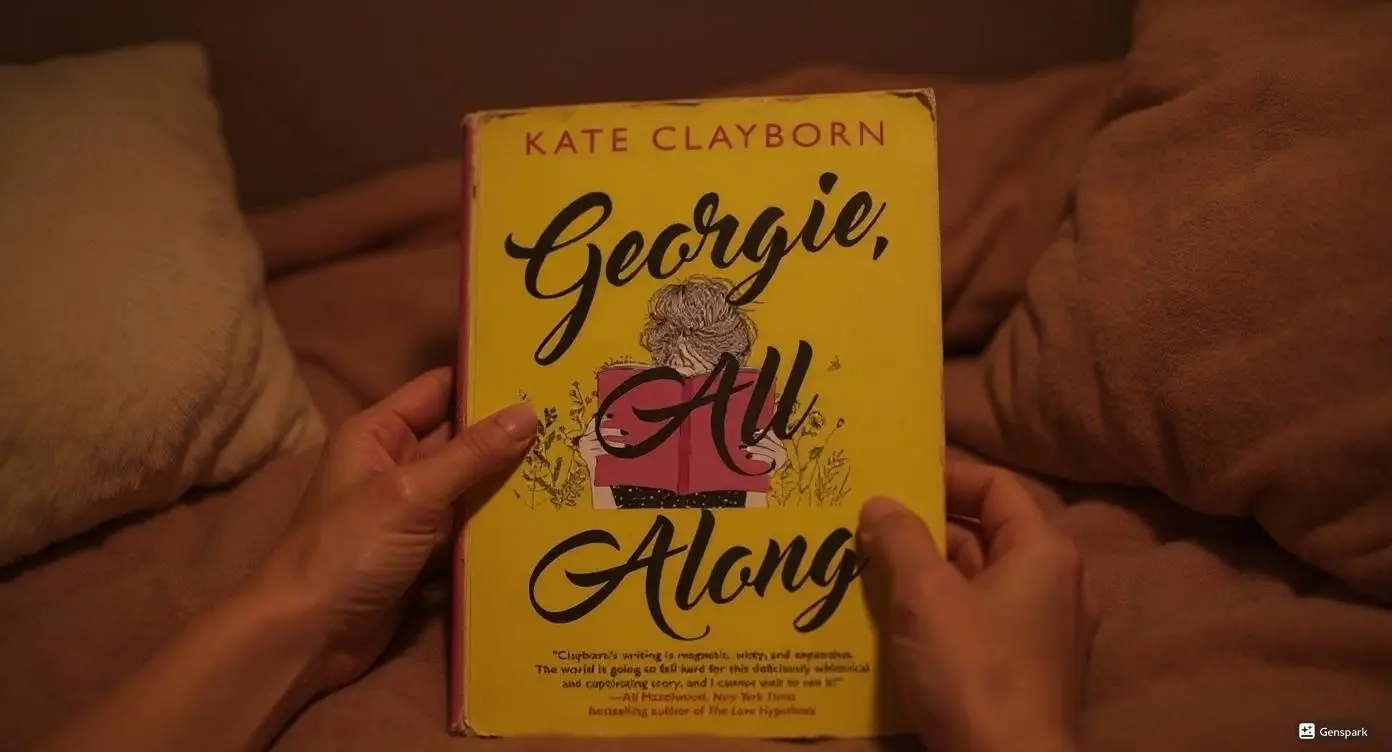I slammed “The Summer Club” shut at 2:47 AM, heart racing from what I’d just read. I picked up this book expecting another predictable beach read, but McKinnon completely blindsided me with emotional depth that left me questioning everything about privilege and belonging. I was curled up in my reading chair with chamomile tea, rain pattering against my window, when chapter twelve hit me like a physical blow.
I’ve been reviewing books for Dionysus Reviews for twenty years, and I can count on one hand the books that made me call my sister at midnight to discuss class dynamics. This book did exactly that. The Mayhaven Beach Club setting becomes a character study of American privilege that cuts deeper than any romance could.
McKinnon refuses to stay in her lane with this one. I found myself ugly-crying over Darcy’s golf trauma and Ned’s quiet desperation to provide opportunities he never had. The neurodiversity representation through Adam’s character broke every stereotype I’ve seen in women’s fiction. I nearly texted my boss about taking a mental health day after finishing this book because it shattered my assumptions about who gets to belong in exclusive spaces.
This isn’t poolside reading – it’s a book that will make you examine your own family’s relationship with money, status, and sacrifice. I kept thinking about my own father’s struggles to give me opportunities he never had, and how that pressure shaped both of us in ways we never discussed.
Key Takeaways
McKinnon’s portrayal of New England’s social hierarchy revealed truths about old money that I’d never seen addressed so directly in fiction. The way privilege operates through whispered exclusions and subtle slights felt authentic and devastating.
Darcy’s golf trauma recovery transcends typical young adult character development by refusing easy solutions or quick healing. I recognized my own perfectionist tendencies in her struggle to return to something she once loved after public failure.
The three-perspective narrative creates a complete social ecosystem where each character’s background shapes their reality in ways that feel genuine rather than constructed. McKinnon trusts readers to understand how personal history distorts perception.
Adam’s neurodivergent perspective adds layers of authenticity that most authors avoid attempting. His direct communication style and social observations provide insights that neurotypical characters miss completely.
The book’s exploration of financial anxiety poisoning family relationships resonated beyond its specific New England setting. Universal themes of parental sacrifice and teenage rebellion make this story accessible across class lines.
Basic Book Details
Publishing Information: July 23, 2024 by Atria Books
Genre: Women’s Fiction / Young Adult
Plot: Darcy Birch and her father Ned navigate the exclusive Mayhaven Beach Club world while dealing with family trauma, financial pressures, and the quest for belonging in New England’s elite social circles.
Series Information: Standalone novel
Page Count: 336 pages
Main Characters:
- Darcy Birch: Sixteen-year-old golfer recovering from tournament trauma that ended her competitive dreams
- Ned Birch: Single father and golf pro carrying the weight of family expectations and financial insecurity
- Adam: Neurodivergent teenager whose direct observations challenge the club’s social assumptions
Book Overview And Setting Analysis
Mayhaven Beach Club As Character And Social Microcosm
I’ve spent time in similar New England establishments, and McKinnon captures the suffocating atmosphere with surgical precision. The club functions as more than backdrop – it’s a living character that embodies American class structure at its most brutal and beautiful.
Every manicured lawn and pristine facility masks social dynamics that can destroy families. I watched Ned navigate these unspoken rules about who belongs, and my chest tightened with recognition. McKinnon shows how these spaces perpetuate inequality behind a veneer of tradition and gentility.
The author doesn’t romanticize this world. She presents it as both idyllic and oppressive, depending on your bank account and social connections. I found myself holding my breath during scenes where characters tried to belong in spaces that tolerated but never truly accepted them.
New England Summer Atmosphere And Authentic Regional Details
McKinnon’s Connecticut roots shine through every humidity-soaked detail. I could smell the chlorine mixed with fresh-cut grass, feel the afternoon thunderstorms rolling across the lake. This isn’t postcard New England – it’s the real thing, complete with the social pressures that simmer beneath perfect surfaces.
The weather becomes a character itself, reflecting the emotional storms brewing between families. I read most of this book during a heat wave, and the atmospheric descriptions made me feel like I was sweating through those club events alongside the characters.
Multi-Perspective Character Development
Darcy Birch’s Golf Trauma And Coming-Of-Age Journey
Darcy’s storyline destroyed me. Her golf trauma isn’t just about sports – it’s about the moment when childhood dreams collide with adult realities and the pressure to be perfect. I’ve seen this pattern in countless books, but McKinnon handles it with brutal honesty that made my hands shake.
The author refuses to offer quick fixes or therapeutic breakthroughs. Darcy’s journey back to the golf course becomes a metaphor for learning to live with failure and disappointment. I recognized my own struggles with perfectionism in her hesitation to try again after public humiliation.
When Darcy finally picks up her clubs again, I actually cheered out loud in my living room. McKinnon earned that moment through pages of authentic emotional groundwork that felt lived-in rather than constructed.
Ned Birch’s Leadership Struggles And Family Patriarch Pressures
Ned’s character arc hit me harder than I expected. As a single father trying to provide opportunities he never had, his quiet desperation feels authentic and devastating. I thought about my own father’s sacrifices while reading Ned’s sections, and found myself crying in unexpected moments.
McKinnon shows how economic anxiety poisons family relationships even when everyone’s trying their best. Ned’s professional expertise earns grudging respect from club members, but social acceptance remains forever out of reach. I felt his frustration in my bones.
His relationship with Darcy reflects the complexity of loving someone while carrying the weight of unfulfilled dreams. Their conversations about golf and life made me want to call my dad and apologize for every time I didn’t appreciate his sacrifices.
Plot Structure And Narrative Technique
Three-Point-Of-View Storytelling Strategy And Effectiveness
McKinnon’s alternating perspectives create a complete picture of Mayhaven’s social ecosystem that no single narrator could provide. I initially worried about confusion, but the technique builds understanding rather than chaos.
Each character sees the same events through lenses shaped by their backgrounds and experiences. This technique works brilliantly during club events where class tensions run high. I found myself rereading conversations to catch details I missed from other perspectives.
The multiple viewpoints reveal how privilege distorts perception and communication. What seems like casual conversation to club members carries completely different weight for the Birch family, and McKinnon makes these differences visceral rather than academic.

Pacing Balance Between Summer Lightness And Deeper Themes
The book’s pacing mirrors a New England summer – languid character development punctuated by sudden storms of conflict. McKinnon knows when to slow down for introspection and when to accelerate toward confrontation.
I appreciated how the author trusted readers to stay engaged during quieter moments. The heavier themes never overwhelm the reading experience because they emerge naturally from character interactions rather than feeling imposed.
The climactic scenes build tension through accumulated social pressure rather than manufactured drama. I found myself speed-reading through the final chapters because I needed to know how these relationships would survive the inevitable explosions.
Thematic Depth And Social Commentary
Class Divide And Economic Privilege In Contemporary New England
McKinnon doesn’t pull punches when examining how wealth creates invisible barriers. The club’s membership fees and social expectations create a caste system that feels both antiquated and depressingly current.
The author’s portrayal of economic inequality goes beyond simple rich-versus-poor dynamics to explore the psychological impact of financial insecurity. I watched Ned calculate the cost of every interaction, and recognized that exhausting mental arithmetic from my own family’s struggles.
The book shows how privilege operates through a thousand small cuts rather than obvious discrimination. Club members don’t need to be openly hostile – their casual assumptions about vacations and expenses create exclusion just as effectively.
Neurodiversity Representation Through Adam’s Character Arc
Adam’s character breaks every stereotype about autism and social acceptance. McKinnon presents his neurodivergent perspective without sentimentality or inspiration porn, and I found his observations about club dynamics refreshingly direct.
His struggles with social expectations feel genuine and important. Adam sees through the club’s polite facades in ways that neurotypical characters miss, and his honesty creates some of the book’s most powerful moments.
I appreciated how McKinnon lets Adam be a complete person rather than a learning opportunity for other characters. His friendship with Darcy develops naturally, based on shared interests rather than charity or inspiration.
Writing Style And Literary Craft
McKinnon’s Dialogue Authenticity And Character Voice Distinction
Each character speaks with a distinct voice that reflects their background and emotional state. Darcy’s teenage frustration sounds authentic without being stereotypical, and Ned’s careful politeness reveals volumes about his social position.
The dialogue never feels forced or expository. Conversations flow naturally while revealing character depth and advancing plot. I found myself listening for the subtext beneath polite exchanges, and McKinnon rewards careful attention.
Adam’s direct communication style provides a counterpoint to the club’s social dancing. His honest observations cut through pretense in ways that made me laugh and wince simultaneously.
Symbolic Use Of Golf And Country Club Traditions
Golf becomes a brilliant metaphor for precision, tradition, and the weight of expectations. McKinnon uses the sport’s rules and rituals to explore themes of perfectionism and social conformity without heavy-handed symbolism.
The golf course’s manicured perfection mirrors the club’s carefully maintained social order. I noticed how McKinnon connects the sport’s individual pressure to the characters’ personal struggles with belonging and achievement.
The traditions and etiquette of club life create a framework for examining how social rules perpetuate inequality. Every golf lesson becomes a lesson in navigating class dynamics.
Genre Positioning And Target Audience
Beach Read Versus Young Adult Fiction Classification Debate
This book defies easy categorization in ways that strengthen rather than confuse its identity. The summer setting and family drama feel familiar, but the thematic depth elevates it beyond typical vacation reading.
I struggled to recommend this book to friends because it crosses so many genre boundaries. The young adult elements feel organic rather than forced, making it accessible to both teen and adult readers who appreciate authentic character development.
The book works as both entertainment and social commentary, offering readers genuine insights into privilege while maintaining the engaging narrative flow that makes pages turn effortlessly.
Comparative Analysis With Elin Hilderbrand And Jennifer Weiner
McKinnon’s work shares DNA with Elin Hilderbrand’s Nantucket novels but with more social consciousness. Like Jennifer Weiner, she balances entertainment with substance, but McKinnon’s focus on class dynamics feels more urgent and less commercial.
The comparison to Weiner feels particularly apt because both authors trust their readers to handle complex themes within accessible storytelling. McKinnon’s examination of privilege feels more systematic and unflinching than typical women’s fiction approaches.
I’d place this book alongside authors who use familiar settings to explore deeper social issues without sacrificing readability or emotional engagement.
Pros
The character development consistently impressed me throughout this novel. McKinnon creates fully realized people rather than plot devices, each carrying authentic emotional weight that drives the narrative forward naturally.
The social commentary feels organic rather than preachy. The author trusts readers to understand the implications of her observations about class and privilege without heavy-handed explanations or moral lectures.
The New England setting comes alive through specific, sensory details that transported me directly into Mayhaven’s world. McKinnon’s familiarity with the region shows in every description of weather, landscape, and social dynamics.
The neurodiversity representation through Adam’s character breaks new ground in women’s fiction. His perspective adds depth and authenticity to the story’s exploration of acceptance and belonging.
The authentic dialogue distinguishes each character’s voice without relying on stereotypes or caricature. Conversations reveal personality and advance plot simultaneously.
Cons
The pacing occasionally slows during introspective passages, particularly in the middle section where character development takes precedence over plot momentum. Some readers might find these slower moments frustrating.
Certain secondary characters feel underdeveloped compared to the main trio. Some club members remain one-dimensional representations of privilege rather than complex individuals with their own motivations.
The resolution feels somewhat rushed after the careful buildup of tensions throughout the story. McKinnon could have spent more time exploring the aftermath of climactic events and their long-term impact on relationships.
Some readers expecting typical beach fiction might be surprised by the book’s serious themes and social commentary. The marketing doesn’t fully prepare readers for the emotional depth.
Final Verdict
“The Summer Club” shattered my expectations by refusing to stay within genre boundaries. McKinnon has crafted a novel that works as both entertainment and social commentary, offering readers genuine insights into class dynamics while maintaining engaging narrative flow.
With my experience, I can confidently say this novel stands out in the crowded women’s fiction market. McKinnon has created something that satisfies both casual readers and those seeking substantial themes.
The book’s exploration of neurodiversity, family trauma, and economic inequality feels particularly relevant in our current social climate. The New England setting might seem narrow, but the themes resonate universally for anyone who’s ever felt like an outsider looking in.
I finished this book feeling emotionally wrung out but intellectually satisfied. McKinnon earned every tear and every moment of recognition I experienced while reading. This is what happens when an author trusts readers to handle complexity within accessible storytelling.
The Summer Club deserves recognition as more than just another beach read. It’s a thoughtful examination of privilege, family, and the cost of belonging that will stay with readers long after the final page.
Dionysus Reviews Rating: 7/10
This book caught my attention because of its unique approach to class dynamics in contemporary New England. Unlike typical beach reads that avoid controversial topics, McKinnon tackles economic inequality head-on while maintaining entertainment value.
I read this during a particularly humid August weekend, which enhanced the atmospheric elements McKinnon crafts so skillfully. The emotional impact surprised me – I expected light entertainment but found myself genuinely moved by the characters’ struggles and triumphs.
People love this book because it offers both escape and substance. The summer setting provides comfort while deeper themes satisfy readers looking for meaningful content. The multi-generational perspective appeals to both young adult and adult audiences.
Published in 2024, this book arrives when discussions about economic inequality dominate cultural conversations. McKinnon’s examination of privilege through an exclusive country club lens feels particularly timely and relevant.
The book requires about 6-8 hours of focused reading time for most readers. The accessible prose style makes it appropriate for strong middle-grade readers through adults, though thematic content works best for mature teens and adults.
I recommend this for readers who enjoy character-driven narratives, social commentary, and authentic portrayals of family dynamics. Fans of Elin Hilderbrand, Jennifer Weiner, and thoughtful women’s fiction will find much to appreciate.
Avoid if you prefer plot-driven narratives, fantasy elements, or strictly escapist reading without social commentary. This book demands emotional engagement with difficult themes.
Perfect for book clubs, summer reading lists, and anyone interested in contemporary examinations of class and privilege in America. The multiple discussion points make it ideal for group conversations.
Sip The Unknown—Discover Stories You Never Knew You’d Love!
Dionysus Reviews Has A Book For Every Mood
Biography & Memoir
Fiction
Mystery & Detective
Nonfiction
Philosophy
Psychology
Romance
Science Fiction & Fantasy
Teens & Young Adult
Thriller & Suspense
Frequently Asked Questions
How does McKinnon handle Adam’s autism representation without falling into stereotypes?
McKinnon presents Adam’s autism with remarkable authenticity by letting him be a complete person rather than a teaching tool. His character challenges other club members’ assumptions while maintaining his own agency and complexity.
I noticed how the author clearly researched neurodivergent experiences thoroughly, creating representation that feels genuine rather than tokenistic. Adam’s direct communication style provides insights that neurotypical characters miss, and his friendship with Darcy develops naturally based on shared interests rather than charity.
What specific moments in the book reveal the true nature of Mayhaven’s class dynamics?
The most revealing moments happen during seemingly casual interactions where privilege operates through subtle exclusions. I was struck by scenes where club members discuss vacation plans or college costs, casually assuming everyone shares their financial reality.
McKinnon shows how Ned calculates the cost of every social interaction, and how Darcy learns to navigate conversations about opportunities she can’t afford. The golf lessons become particularly powerful metaphors for the precision required to belong in spaces that tolerate but never truly accept you.
How does the three-perspective narrative structure enhance the story’s social commentary?
The alternating viewpoints create a complete picture of Mayhaven’s social ecosystem that reveals how privilege distorts perception. Each character sees the same events through lenses shaped by their backgrounds and experiences. I found myself rereading conversations to catch details I missed from other perspectives.
What seems like casual conversation to club members carries completely different weight for the Birch family, and McKinnon makes these differences visceral rather than academic. The technique works brilliantly during club events where class tensions run high.
Why does McKinnon choose golf as the central metaphor for social belonging?
Golf serves as the perfect metaphor because it demands precision, follows strict traditions, and emphasizes individual performance under pressure. The sport mirrors the characters’ struggles with expectations and perfectionism beautifully.
I noticed how McKinnon connects the golf course’s manicured perfection to the club’s carefully maintained social order. The rules and etiquette of golf become a framework for examining how social conventions perpetuate inequality. Every golf lesson becomes a lesson in navigating class dynamics and the weight of tradition.
What sets this book apart from other New England summer fiction?
The Summer Club distinguishes itself through its unflinching examination of class dynamics and economic inequality. Most books in this genre romanticize wealthy enclaves, but McKinnon reveals the psychological costs of exclusivity and privilege. The neurodiversity representation and focus on family trauma elevate it beyond typical beach fiction.
I appreciated how the author tackles controversial topics while maintaining the engaging narrative flow that makes summer fiction appealing. The social commentary emerges naturally from character interactions rather than feeling forced or preachy.









